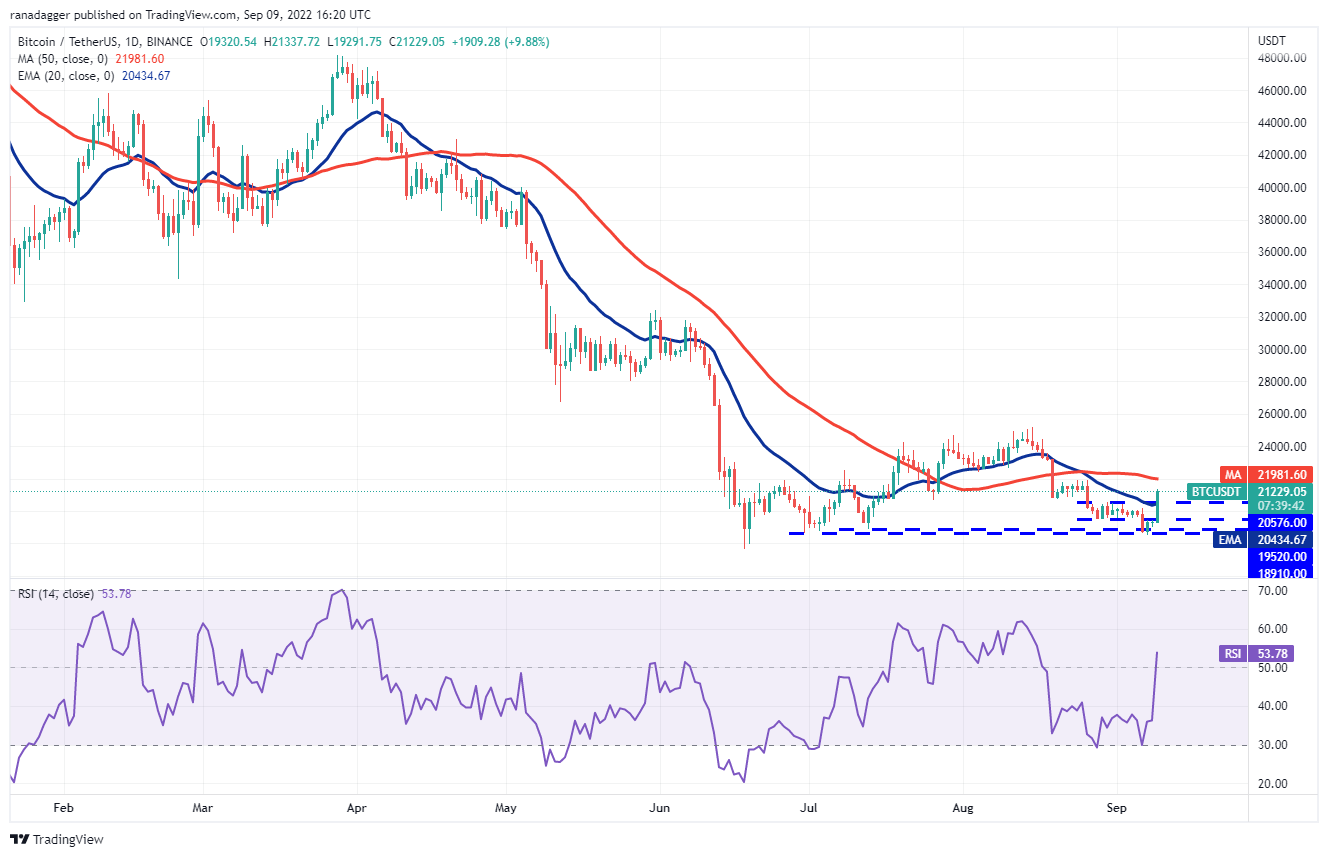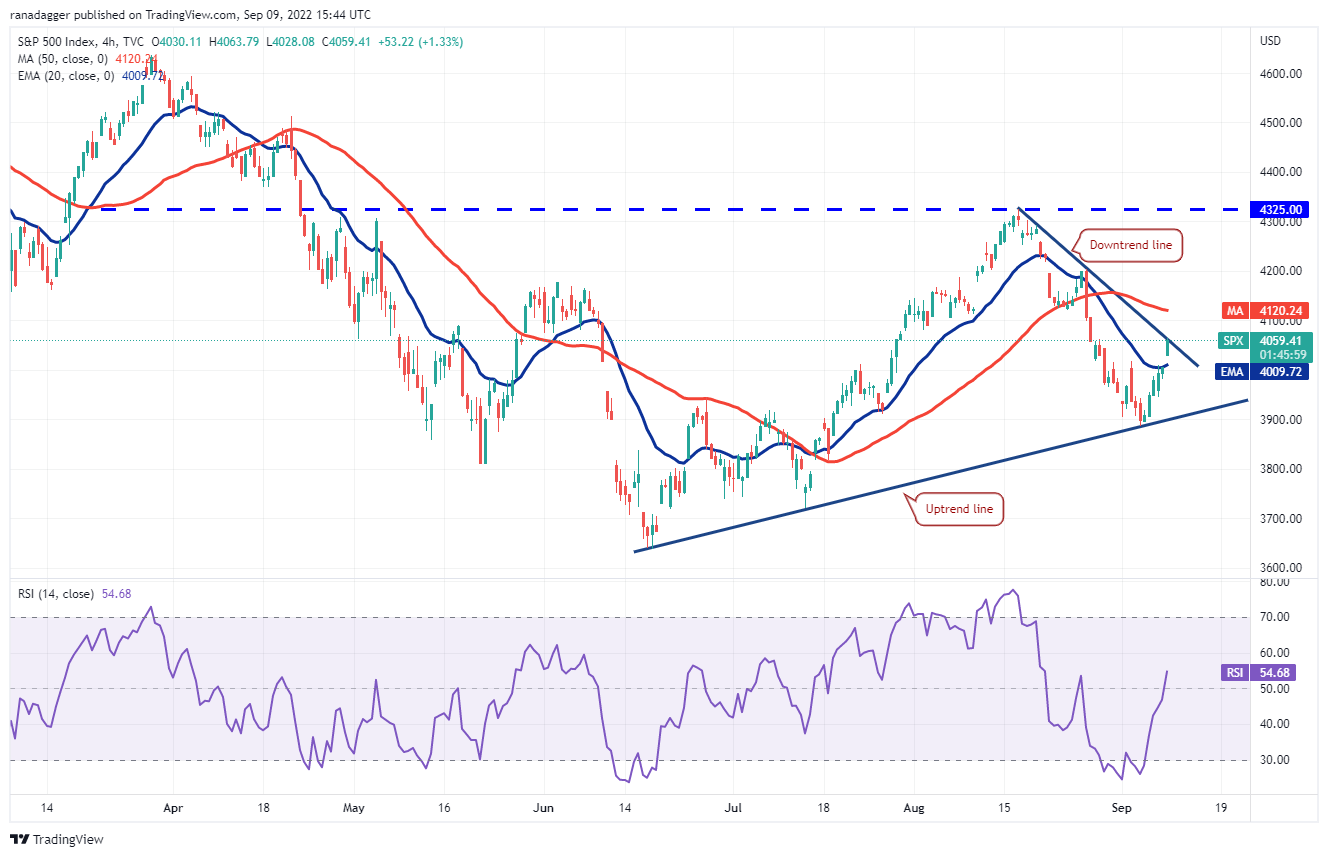Will Bitcoin’s rally sustain? DXY, SPX, GC and WTI could have the answer

Federal Reserve Chairman Jerome Powell said in a question and answer session hosted by the Cato Institute on Sept. 8 that the central bank will continue to hike rates until inflation is under control. However, these comments did not rattle the markets as much as most would have anticipated, indicating that traders might have already factored in a 75 basis point rate hike in the Fed’s next meeting on Sept. 20-21.
Bitcoin has been strongly correlated with the S&P 500 and inversely correlated with the United States dollar index (DXY) for the past several weeks. With the DXY cooling off after hitting a two-decade high, risky assets have been attempting a recovery.

Crypto market data daily view. Source:Coin360
U.S. equities markets are attempting to snap a three-week losing streak while Bitcoin (BTC) has soared above the psychological level at $21,000.
Does the rally in the equities and crypto markets indicate that the risk-on sentiment is back? Let’s analyze five asset classes to review their trends and determine where they might go in the next few days.
BTC/USDT
Bitcoin rebounded off the strong support at $18,626 on Sept. 7 and broke back above the breakdown level of $19,520 on Sept. 9. This may have triggered short-covering by the aggressive bears which propelled the price above the 20-day exponential moving average ($20,434).

BTC/USDT daily chart. Source: TradingView
The relative strength index (RSI) has risen into the positive territory and the 20-day EMA is flattening out, indicating that the bears may be losing their grip.
The 50-day simple moving average ($21,981) may act as a minor hurdle, but if bulls overcome it, the BTC/USDT pair could rally to the overhead resistance at $25,211. A break and close above this level could complete a double bottom pattern. Such a move may signal the start of a new up-move. The pattern target of this reversal setup is $31.796.
Contrary to this assumption, if the price turns down from the 50-day SMA or $25,211, the pair could enter a consolidation for a few days.

BTC/USDT 4-hour chart. Source: TradingView
The 4-hour chart shows that the pair picked up momentum after breaking above $19,520. The moving averages have completed a bullish crossover, indicating advantage to buyers but the RSI in the overbought zone suggests a minor consolidation or correction in the short term.
If the price turns down from the current level or the overhead resistance at $21,900 but does not break below $20,576, it will suggest that the sentiment has changed from selling on rallies to buying on dips. That could increase the likelihood of a break above $21,900.
The first sign of weakness will be a break and close below the moving averages. If that happens, it will suggest that the current rise may have been a sucker’s rally.
DXY
The U.S. dollar index (DXY) is correcting in a strong uptrend. After hitting a multi-year high at 110.78, the index has witnessed profit-booking which has pulled the price to the 20-day EMA ($108.64).

DXY daily chart. Source: TradingView
Although the rising moving averages indicate advantage to buyers, the RSI has formed a negative divergence, indicating that the bullish momentum could be weakening. If the price sustains below the 20-day EMA, the next stop could be the uptrend line.
This is an important level to keep an eye on because a break and close below it could indicate a potential trend change. The index could then decline to 104.63. A break below this level could suggest that the index may have topped out.
Conversely, if the price rebounds off the moving averages with strength, it will indicate that the sentiment remains bullish and traders are viewing the dips as a buying opportunity. If bulls push the price above 110.78 the rally could extend to 113.95.

DXY 4-hour chart. Source: TradingView
The 20-EMA has turned down on the 4-hour chart and the RSI is in the negative territory, indicating that bears have the upper hand in the near term. The index could drop to the immediate support at 108.
If the price rebounds off 108 but fails to break above the 20-EMA, it will suggest that the sentiment has shifted from buying on dips to selling on rallies. That could increase the likelihood of a break below 108. If that happens, the index could start a deeper correction.
Contrary to this assumption, if the price turns up from the current level and breaks above the 20-EMA, the index could rise to 110.24 and then to 110.78. Buyers will have to overcome this barrier to indicate the resumption of the uptrend.
SPX
The S&P 500 is in a bottoming formation and is attempting to form a higher floor near 3,900. The price rebounded off the uptrend line, indicating that lower levels are attracting buyers.

SPX daily chart. Source: TradingView
The 20-day EMA (4,050) is an important level to watch out for in the near term. If bulls drive the price above this resistance, it will suggest that the latest leg of the correction may have ended.
The index could thereafter attempt a rally to 4,200. This level may act as a minor hurdle but if bulls overcome it, the recovery could reach the critical overhead resistance at 4,325.
This positive view could invalidate in the short term if the price turns down from the 20-day EMA. If that happens, the bears will attempt to sink the price below the uptrend line. If they succeed, the decline could reach major support at 3,700.

SPX 4-hour chart. Source: TradingView
The 4-hour chart shows that the recent correction pulled the RSI into the oversold territory. That started a bounce, which reached the downtrend line. Buyers will have to push the price above this resistance to indicate a potential trend change. The index could then rise to the 50-SMA and later to 4,200.
Conversely, if the price turns down from the downtrend line and slips below the 20-EMA, it will suggest that bears continue to sell on rallies. The bears will then attempt to sink the price below 3,886 and resume the downward move.
Related: Bitcoin price cracks $21K as trader says BTC buy now ‘very compelling’
GC
Gold futures (GC) is in a downtrend but it is attempting to form a higher low at $1,700. The price has reached the moving averages, which is acting as a strong resistance as seen from the long wick on the Sept. 9 candlestick.

GC daily chart. Source: TradingView
If the price turns down from the current level, it will suggest that the sentiment remains negative and traders are selling on rallies. The bears will then make one more attempt to sink the price below $1,700 and challenge the crucial support at $1,675.
Conversely, if the price turns up and breaks above the moving averages, it will suggest that the bears may be losing their grip. That could push the price to the downtrend line. A break and close above this resistance could indicate that the downtrend may be over. That could start a rally to $1,825.

GC 4-hour chart. Source: TradingView
The 4-hour chart shows bears are aggressively defending the overhead resistance at $1,737.40. If the price slips below the moving averages, the decline could extend to $1,700. That will suggest a range-bound action between $1,700 and $1,737.40 for some more time.
Alternatively, if the price turns up from the moving averages, it will suggest that bulls are buying on minor dips. The bulls will then try to propel the price above $1,741. If they succeed, a rally to $1,774.80 is possible.
CL
Crude oil futures (CL) has been in a downtrend for the past several weeks. Buyers attempted to start a sustained recovery in August but the bears successfully defended the 50-day SMA ($94) on Aug. 30.

CL daily chart. Source: TradingView
The bulls tried to arrest the decline near $85.73 but the level cracked on Sept. 7 and crude oil resumed its downtrend. A minor positive is that the bulls have not allowed the bearish momentum to pick up. This indicates buying at lower levels. The bulls are attempting to push the price back above the breakdown level of $85.73.
This is an important level to keep an eye on because if the price sustains above $85.73, it could catch several aggressive bears off guard. That could result in a short squeeze and the price could rise to the 50-day SMA.
Conversely, if the price turns down from $85.73, it will indicate that bears have flipped the level into resistance. The sellers will then try to resume the downtrend by pulling the price below $81.20. If they succeed, the decline could extend to $70.

CL 4-hour chart. Source: TradingView
Crude Oil’s 4-hour chart shows a positive divergence on the RSI. This suggests that the negative momentum could be weakening. Buyers have pushed the price above the 20-EMA and the breakdown level of $85.73, which is the first indication that the selling pressure could be reducing. The rally could next extend to $88.
Alternatively, if the price fails to sustain above $85.73, the bears will try to sink the price back below the 20-EMA. If they succeed, the price could dip to $82.71 and later to $81.20.
The views and opinions expressed here are solely those of the author and do not necessarily reflect the views of Cointelegraph. Every investment and trading move involves risk, you should conduct your own research when making a decision.






 Bitcoin
Bitcoin  Ethereum
Ethereum  Tether
Tether  USDC
USDC  TRON
TRON  Dogecoin
Dogecoin  Cardano
Cardano  Bitcoin Cash
Bitcoin Cash  Chainlink
Chainlink  LEO Token
LEO Token  Monero
Monero  Stellar
Stellar  Zcash
Zcash  Litecoin
Litecoin  Hedera
Hedera  Dai
Dai  Cronos
Cronos  OKB
OKB  Tether Gold
Tether Gold  Ethereum Classic
Ethereum Classic  KuCoin
KuCoin  Gate
Gate  Algorand
Algorand  Cosmos Hub
Cosmos Hub  VeChain
VeChain  Dash
Dash  Tezos
Tezos  TrueUSD
TrueUSD  Stacks
Stacks  IOTA
IOTA  Basic Attention
Basic Attention  Theta Network
Theta Network  Decred
Decred  NEO
NEO  Synthetix
Synthetix  Qtum
Qtum  Ravencoin
Ravencoin  0x Protocol
0x Protocol  DigiByte
DigiByte  Zilliqa
Zilliqa  Nano
Nano  Holo
Holo  Numeraire
Numeraire  Siacoin
Siacoin  Waves
Waves  Ontology
Ontology  BUSD
BUSD  Status
Status  Enjin Coin
Enjin Coin  Pax Dollar
Pax Dollar  Hive
Hive  Lisk
Lisk  Steem
Steem  Huobi
Huobi  NEM
NEM  OMG Network
OMG Network  Bitcoin Gold
Bitcoin Gold  Augur
Augur  Ren
Ren